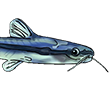I have heard rumors that these fish have been spawned successfully, and I'm just wondering if anyone happens to have an inside scoop.
I have a large selection of both sexes, and I plan to try for a spawn sometime this year. As far as I know a successful spawn has not been documented, but there could be some hobbyists out there that know the trigger. I'm just shooting in the dark to see if anyone might have any helpful tips. I have two huge, healthy and very fat females already picked out for potential parents, and some healthy males with very distinct markings.
Currently I am getting practice with my Hisonotus notatus. The tank was originally going to (hopefully) be my zebra oto breeding tank, but when my hiso's started to spawn I moved them in. They wouldn't stop spwaning if I wanted them to, but trying to raise the fry has proved to be a challenge so far. I have some new ideas for my next hatch, and I'm hoping for a much better survival rate.
If anyone has some insight of any kind I would be very interested in hearing it!
Otocinclus cocama
- Silurus
- Posts: 12442
- Joined: 31 Dec 2002, 11:35
- I've donated: $12.00!
- My articles: 55
- My images: 895
- My catfish: 1
- My cats species list: 90 (i:0, k:0)
- Spotted: 426
- Location 1: Singapore
- Location 2: Moderator Emeritus
Thanks for the link Silurus! I had done a few searches with different terms (on many sites besides this one as well), and came up with nothing. It's good to hear that they have been spawned, and I'm glad I have some Hisonotus so I can experiment with fry raising techniques. Hopefully I can come up wih a good method of raising the fry before I try for a zebra oto spawn.
Any more input would be much appreciated as well!
Any more input would be much appreciated as well!





